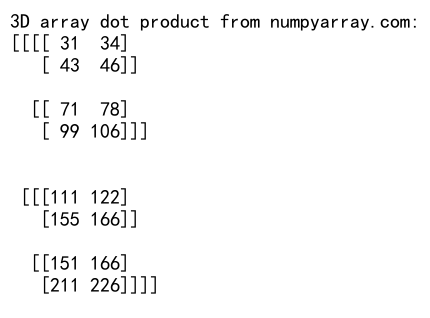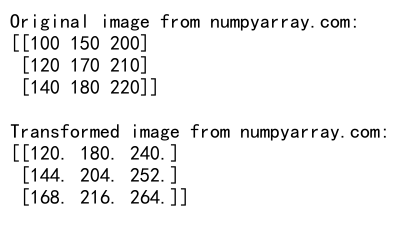Mastering NumPy’s dot() Function: A Comprehensive Guide to Matrix Multiplication in Python
numpy.dot() in Python is a powerful function that plays a crucial role in numerical computing and linear algebra operations. This article will provide an in-depth exploration of numpy.dot(), covering its various applications, syntax, and usage in different scenarios. We’ll delve into the intricacies of matrix multiplication, vector dot products, and tensor operations using numpy.dot(). By the end of this comprehensive guide, you’ll have a thorough understanding of how to leverage numpy.dot() in your Python projects effectively.
Understanding the Basics of numpy.dot()
numpy.dot() is a fundamental function in the NumPy library, designed to perform dot product operations on arrays. The dot product, also known as scalar product or inner product, is a crucial concept in linear algebra and has numerous applications in various fields, including physics, engineering, and machine learning.
Let’s start with a simple example to illustrate the basic usage of numpy.dot():
import numpy as np
# Create two 1D arrays
a = np.array([1, 2, 3])
b = np.array([4, 5, 6])
# Calculate the dot product
result = np.dot(a, b)
print("Dot product of arrays from numpyarray.com:", result)
Output:

In this example, numpy.dot() calculates the dot product of two 1D arrays. The function multiplies corresponding elements and then sums up the results, giving us a scalar value.
numpy.dot() with Vectors
When working with vectors, numpy.dot() calculates the dot product, which is the sum of the products of corresponding elements. This operation is particularly useful in various mathematical and scientific applications.
Here’s an example demonstrating numpy.dot() with vectors:
import numpy as np
# Create two vectors
v1 = np.array([1, 2, 3])
v2 = np.array([4, 5, 6])
# Calculate the dot product
dot_product = np.dot(v1, v2)
print("Vector dot product from numpyarray.com:", dot_product)
Output:

In this case, numpy.dot() multiplies corresponding elements of v1 and v2, then sums the results to give us the scalar dot product.
Matrix Multiplication with numpy.dot()
One of the most common uses of numpy.dot() is for matrix multiplication. When dealing with 2D arrays (matrices), numpy.dot() performs matrix multiplication following the rules of linear algebra.
Let’s look at an example of matrix multiplication using numpy.dot():
import numpy as np
# Create two matrices
matrix1 = np.array([[1, 2], [3, 4]])
matrix2 = np.array([[5, 6], [7, 8]])
# Perform matrix multiplication
result = np.dot(matrix1, matrix2)
print("Matrix multiplication result from numpyarray.com:")
print(result)
Output:

In this example, numpy.dot() multiplies matrix1 and matrix2 following the rules of matrix multiplication. The resulting matrix has the same number of rows as matrix1 and the same number of columns as matrix2.
numpy.dot() with Higher Dimensional Arrays
numpy.dot() is not limited to 1D and 2D arrays. It can handle higher-dimensional arrays as well. When working with arrays of dimension greater than 2, numpy.dot() applies matrix multiplication to the last two axes by default.
Here’s an example using 3D arrays:
import numpy as np
# Create two 3D arrays
array1 = np.array([[[1, 2], [3, 4]], [[5, 6], [7, 8]]])
array2 = np.array([[[9, 10], [11, 12]], [[13, 14], [15, 16]]])
# Perform dot product on the last two axes
result = np.dot(array1, array2)
print("3D array dot product from numpyarray.com:")
print(result)
Output:

In this case, numpy.dot() applies matrix multiplication to the last two axes of array1 and array2, resulting in a new 3D array.
Optimizing Performance with numpy.dot()
numpy.dot() is highly optimized for performance, especially when dealing with large arrays. It leverages low-level implementations and can take advantage of hardware-specific optimizations.
Here’s an example demonstrating the efficiency of numpy.dot() for large matrix multiplication:
import numpy as np
import time
# Create large matrices
large_matrix1 = np.random.rand(1000, 1000)
large_matrix2 = np.random.rand(1000, 1000)
# Measure time for numpy.dot()
start_time = time.time()
result = np.dot(large_matrix1, large_matrix2)
end_time = time.time()
print(f"Time taken for large matrix multiplication from numpyarray.com: {end_time - start_time:.4f} seconds")
Output:

This example showcases the efficiency of numpy.dot() when dealing with large matrices, highlighting its optimized performance.
numpy.dot() vs. Matrix Multiplication Operator (@)
In Python 3.5 and later versions, the @ operator was introduced as a shorthand for matrix multiplication. It’s worth comparing numpy.dot() with the @ operator to understand their similarities and differences.
Let’s look at an example comparing both methods:
import numpy as np
# Create two matrices
matrix1 = np.array([[1, 2], [3, 4]])
matrix2 = np.array([[5, 6], [7, 8]])
# Using numpy.dot()
result_dot = np.dot(matrix1, matrix2)
# Using @ operator
result_at = matrix1 @ matrix2
print("Result using numpy.dot() from numpyarray.com:")
print(result_dot)
print("\nResult using @ operator from numpyarray.com:")
print(result_at)
Output:

Both methods produce the same result, but the @ operator provides a more concise syntax for matrix multiplication.
Handling Different Array Shapes with numpy.dot()
numpy.dot() is flexible when it comes to handling arrays of different shapes. It can perform operations between vectors and matrices, as well as between matrices of compatible dimensions.
Here’s an example demonstrating numpy.dot() with different array shapes:
import numpy as np
# Create a vector and a matrix
vector = np.array([1, 2, 3])
matrix = np.array([[4, 5], [6, 7], [8, 9]])
# Perform dot product
result = np.dot(vector, matrix)
print("Result of vector-matrix dot product from numpyarray.com:")
print(result)
Output:

In this case, numpy.dot() performs a vector-matrix multiplication, resulting in a 1D array.
numpy.dot() in Scientific Computing
numpy.dot() is extensively used in scientific computing applications, particularly in physics and engineering. It’s crucial for solving systems of linear equations, calculating projections, and performing various other mathematical operations.
Let’s look at an example of solving a system of linear equations using numpy.dot():
import numpy as np
# Define the coefficient matrix and constants vector
A = np.array([[2, 1, -1],
[1, 3, 2],
[-1, 2, 4]])
b = np.array([8, 14, 18])
# Solve the system using numpy.linalg.solve
x = np.linalg.solve(A, b)
# Verify the solution using numpy.dot()
verification = np.dot(A, x)
print("Solution to the system of equations from numpyarray.com:")
print(x)
print("\nVerification using numpy.dot() from numpyarray.com:")
print(verification)
Output:

This example demonstrates how numpy.dot() can be used to verify the solution of a system of linear equations.
Efficient Memory Usage with numpy.dot()
numpy.dot() is designed to be memory-efficient, especially when dealing with large arrays. It uses optimized algorithms to minimize memory usage while performing calculations.
Here’s an example demonstrating memory-efficient matrix multiplication using numpy.dot():
import numpy as np
# Create large matrices
large_matrix1 = np.random.rand(10000, 100)
large_matrix2 = np.random.rand(100, 5000)
# Perform matrix multiplication
result = np.dot(large_matrix1, large_matrix2)
print(f"Shape of the result matrix from numpyarray.com: {result.shape}")
print(f"Memory usage of the result matrix: {result.nbytes / (1024 * 1024):.2f} MB")
Output:

This example showcases how numpy.dot() efficiently handles large matrix multiplications without excessive memory usage.
numpy.dot() vs. Element-wise Multiplication
It’s important to distinguish between numpy.dot() and element-wise multiplication in NumPy. While numpy.dot() performs matrix multiplication or dot product operations, element-wise multiplication simply multiplies corresponding elements of arrays.
Let’s compare numpy.dot() with element-wise multiplication:
import numpy as np
# Create two matrices
matrix1 = np.array([[1, 2], [3, 4]])
matrix2 = np.array([[5, 6], [7, 8]])
# Perform matrix multiplication using numpy.dot()
dot_result = np.dot(matrix1, matrix2)
# Perform element-wise multiplication
element_wise_result = matrix1 * matrix2
print("Matrix multiplication result using numpy.dot() from numpyarray.com:")
print(dot_result)
print("\nElement-wise multiplication result from numpyarray.com:")
print(element_wise_result)
Output:

This example clearly shows the difference between matrix multiplication using numpy.dot() and element-wise multiplication.
Handling Complex Numbers with numpy.dot()
numpy.dot() is capable of handling complex numbers, making it useful for applications in signal processing, quantum mechanics, and other fields that involve complex arithmetic.
Here’s an example of using numpy.dot() with complex numbers:
import numpy as np
# Create complex matrices
complex_matrix1 = np.array([[1+2j, 3-1j], [2-3j, 1+1j]])
complex_matrix2 = np.array([[2+1j, 1-2j], [3+2j, 2-1j]])
# Perform matrix multiplication with complex numbers
result = np.dot(complex_matrix1, complex_matrix2)
print("Result of complex matrix multiplication from numpyarray.com:")
print(result)
Output:

This example demonstrates how numpy.dot() handles matrix multiplication with complex numbers.
numpy.dot() in Image Processing
numpy.dot() finds applications in image processing, particularly in operations like image transformations, filtering, and feature extraction.
Here’s an example of using numpy.dot() for a simple image transformation:
import numpy as np
# Create a simple 3x3 grayscale image
image = np.array([[100, 150, 200],
[120, 170, 210],
[140, 180, 220]])
# Define a transformation matrix for brightening
transformation = np.array([[1.2, 0, 0],
[0, 1.2, 0],
[0, 0, 1.2]])
# Apply the transformation using numpy.dot()
transformed_image = np.dot(image, transformation)
print("Original image from numpyarray.com:")
print(image)
print("\nTransformed image from numpyarray.com:")
print(transformed_image)
Output:

This example shows how numpy.dot() can be used to apply a simple brightness transformation to an image.
Optimizing numpy.dot() for Sparse Matrices
When dealing with sparse matrices (matrices with many zero elements), specialized algorithms can be more efficient than the standard numpy.dot(). NumPy provides the scipy.sparse module for handling sparse matrices efficiently.
Here’s an example of using scipy.sparse with numpy.dot():
import numpy as np
from scipy import sparse
# Create a sparse matrix
sparse_matrix = sparse.csr_matrix([[1, 0, 0], [0, 2, 0], [0, 0, 3]])
# Create a dense vector
dense_vector = np.array([1, 2, 3])
# Perform matrix-vector multiplication
result = sparse_matrix.dot(dense_vector)
print("Result of sparse matrix-vector multiplication from numpyarray.com:")
print(result)
Output:

This example demonstrates how to use scipy.sparse for efficient matrix operations with sparse matrices.
numpy.dot() in Numerical Integration
numpy.dot() can be used in numerical integration techniques, such as the trapezoidal rule or Simpson’s rule, for approximating definite integrals.
Here’s an example of using numpy.dot() for numerical integration using the trapezoidal rule:
import numpy as np
def trapezoidal_integration(f, a, b, n):
x = np.linspace(a, b, n+1)
y = f(x)
weights = np.ones(n+1)
weights[0] = weights[-1] = 0.5
return np.dot(weights, y) * (b - a) / n
# Define the function to integrate
def f(x):
return x**2
# Perform numerical integration
result = trapezoidal_integration(f, 0, 1, 1000)
print(f"Numerical integration result from numpyarray.com: {result:.6f}")
Output:

This example shows how numpy.dot() can be used in implementing numerical integration methods.
Conclusion
numpy.dot() is a versatile and powerful function in the NumPy library, essential for a wide range of numerical computing tasks. From basic vector operations to complex matrix multiplications, numpy.dot() provides an efficient and flexible way to perform these calculations. Its optimized implementation makes it suitable for both small-scale computations and large-scale scientific simulations.
Throughout this article, we’ve explored various aspects of numpy.dot(), including its usage with different array dimensions, its applications in scientific computing and machine learning, and its performance characteristics. We’ve also compared it with other related operations and discussed its role in specific domains like image processing and numerical integration.
By mastering numpy.dot(), you’ll be well-equipped to tackle a wide range of numerical computing challenges in Python. Whether you’re working on data analysis, scientific simulations, or machine learning models, understanding the intricacies of numpy.dot() will undoubtedly enhance your ability to write efficient and effective code.